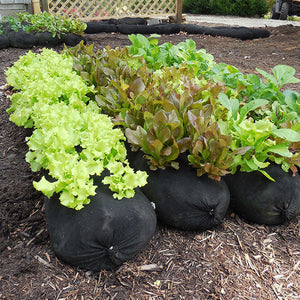If you are familiar with how to grow Collard Greens, you may have noticed they hold a slight similarity to cabbage. In fact, Collard Greens are part of the same genus as cabbage, the Brassica family. Also known simply as “collards”, this leafy yet cold-hardy vegetable is often used in Southern American cuisine.
With a slightly bitter taste and tough stems, collards are typically soaked in water and then cooked with salted meat like bacon to balance their flavor. They are excellent in supporting the digestive system and contain high levels of Vitamins C and A, which are ideal for boosting the immune system.

Growing collard greens in GardenSoxx® | Plant Family: Brassicaceae
Different Varieties of Collard Greens
Exploring the different varieties of Collard Greens will allow you to make an informed choice about which is right for your garden:
Champion Collards have a dark green coloring and are excellent for colder growing zones. They are quite resistant to bolting, allowing continuous harvest throughout the growing season.
Doubling as an ornamental plant for your landscape, Old Timey Blue Collard’s unique coloring and broad leaves make them as attractive as they are delicious. Their seed-to-harvest time is around 70 days and they should be planted in early spring to benefit from cooler temperatures.
Less bitter than some other cultivars, Georgia Collards have a mild flavor that gets even better after a slight frost. This variety produces an abundant harvest and looks quite similar to cabbage leaves.
With a unique shiny green leaf, Green Glaze Collards have a stronger, peppery flavor and take closer to 80 days or more to mature. They are a hardy choice that tends to resist pest and disease damage, making them popular among home and market growers.
Nutritional Information For Collard Greens
Nutritional Facts - per 100/g
| Nutrient | Amount | % Daily Value |
|---|---|---|
| Calories | 32 | - |
| Total Fat | 0.6 g | - |
| Sodium | 17 mg | - |
| Potassium | 213 mg | - |
| Dietary Fiber | 4 g | - |
| Sugar | 0.5 g | - |
| Protein | 3 g | - |
| Vitamin C | - | 58% |
| Iron | - | 2% |
| Vitamin B6 | - | 10% |
| Magnesium | - | 6% |
| Calcium | - | 23% |
How to Grow Collard Greens in Your GardenSoxx®
Seeds can be sown directly in soil, ½ an inch deep, 12 inches apart, two weeks before the last spring frost. Alternatively, collards can be sown in summer about 7 weeks before the first fall frost and harvested well into the cooler season.
Collard Greens Seed to Harvest Time: Approximately 80 days

How to Harvest Collard Greens
Collards can actually be harvested anytime after they set leaves - the young and tender first leaves can be used in salads as microgreens, while the more mature leaves are excellent for sauteed and steamed side dishes. For larger leaves, you can pick the outer leaves and allow the rest to continue growing through the season.























































